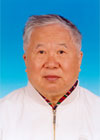

City Planner and Architect, was born in Nanjing, Jiangsu Province, on May 7, 1922. He graduated from the Department of Architecture at National Central University in Chongqing in 1944 with a Bachelor Degree of Engineering. He went to the Cranbrook Academy of Art, Bloomfield Hills, Michigan in 1948 and received Master Degree of Architecture and Urban Design in 1949. He is a Member of Chinese Academy of Sciences and a member of Chinese Academy of Engineering. Now he is the Director of Architecture and Urban Research Institute, Director of Human Settlements Research Center of Tsinghua University.
He has been engaged in teaching, researching and practicing in the fields of urban planning and designing, architecture design, landscape architecture planning and design. He creatively proposed that the General theory of architecture and theory of Sciences of human settlements, his publications including A General Theory of Architecture, The Introduction Sciences of Human Settlements, UIA Beijing Charter, Research on the Rural and Urban Spatial Development Planning for the Greater Beijing Region (Beijing, Tianjin and Hebei),Consideration on Transformation of Development Mode and Urban-Rural Construction of China etc.
Sciences of Human Settlements
Abstract
Wu Liangyong creatively approaches a theoretic system of Sciences of Human Settlements. Focusing on architecture, urban planning and landscape design, the theoretic system of Sciences of Human Settlements integrates relevant disciplines of geography, ecology, society, and engineering, endeavors to construct a scientific theoretical system with Chinese characteristics, and extends both the academic realms of architecture and urban planning. This theory provides with scientific guidance to current rapid urbanization and large-scale constructions, and it also respects the expression of Chinese historical traditions as well as cultural values. The Union International des Architects(UIA)'s 'Beijing Charter', drafted by Wu Liangyong plays as a roadmap for architects and planners in recognizing the issues of human settlements and building better human settlements all over the world.